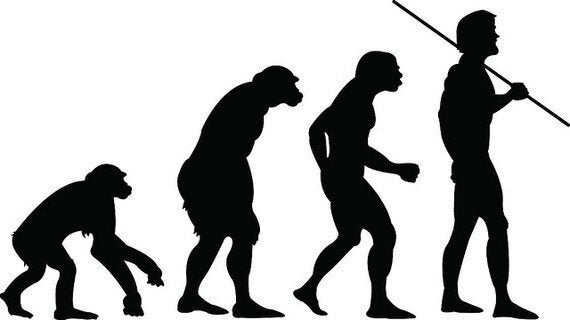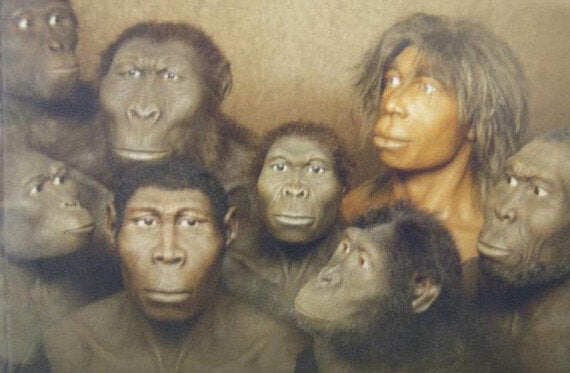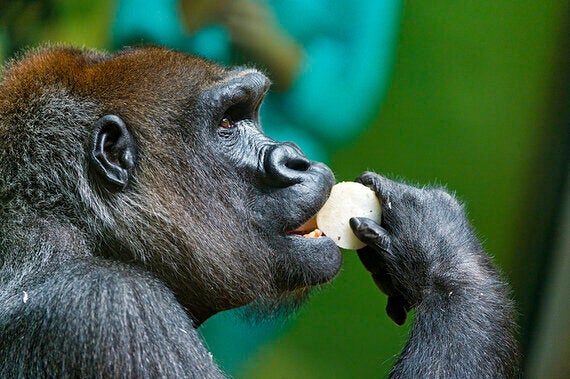Almost all scientists agree upon the fundamental principles of the theory of evolution as scientific fact. The research conducted and discoveries associated with evolutionary anthropology have given us a greatly developed understanding of our ancestors and origins. A common misconception in the understanding of human evolution is that we are directly descended from monkeys or apes that are present today. In actuality, modern day primates and ourselves share a common ancient ancestor from which we both derive, and that a complete path from that ancestor to us would be immensely difficult to sequence. What we can do today is build up an overview of the branching of ancestors and relatives, whom some of which we lived side-by-side for thousands of years, to create a picture detailing both our development from early bi-pedal human-like animals and our slow and complex migration and assimilation across the globe.
Primal Primates

Image courtesy of Bryan Wright
A recently discovered early primate has revealed that a distant ancient relative of modern day humans may have evolved earlier than originally thought. The primate fossil resembles modern day tarsiers from south-east Asia and is believed to be 55 million years old.
Although not a direct link to an early human origin, the fossil which is one of the earliest primate fossils ever discovered, does belong to the same group as humans do today. It is believed to have lived in trees and eaten insects.
Other fossils such as the 47 million year old fossil of a lemur like creature give scientists an insight into the bridges that are still missing between gaps in the fossil records. Fossils that describe the transition between types of life form, such as the feathered dinosaur Archeopteryx, are extremely valuable in deciphering the development of early primates and their link to human beings and our ancestors.
Meet the Hominins

Image courtesy of Travis
To date over 20 different species of human-like animals which can be grouped together as hominins have been discovered. Our own species of which all modern-humans comprise is Homo sapiens. Characteristics of our species were possibly developing as early as 400,000 years ago in eastern and southern Africa, and the species as is it scientifically described today evolved around 150,000 years ago.
About the same amount of time ago as the evolution of Homo sapiens, Homo neanderthalensis evolved in western Eurasia. These early relatives dubbed Neanderthals due to being first discovered in the Neander Valley in Germany, were stockier, had more pronounced facial extremities and perhaps had more body hair. They shared the same skull and brain size as modern humans, and evidence suggests they buried their dead and crafted simple bead jewellery.
Both Homo sapiens and Neanderthals are thought to have shared the same ancestor roughly 400,000 years ago. Some scientists believe that the species known as Homo heidelbergensis may have been that link. This species of homonin is believed to be the first to build simple shelters and its fossil remains are often discovered with simple tool hand axes.
The longest lived relative of our species was Homo erectus, possibly spanning a time frame from 1.8 million to 200,000 years ago. They were the first migratory species of our known ancestors and relatives, and could have been the first to control fire. Both these traits are long-lasting characteristics of human beings today.
The earliest found to date human ancestor, whom has been proven to walk regularly on two legs, evolved almost 4 million years ago. A largely complete fossil example of Australopithecus afarensis known as "Lucy" gave scientists invaluable insight into our early ancestors, and in 2008 a further species of Australopithecus, A. sediba was discovered in South Africa, and could possibly be a direct evolutionary step between our more ape-like ancient ancestors and our own species' genus - Homo.
Living with Ancestors

Image courtesy of Adam Foster
Living alongside early modern humans were several other species of homo. The interaction between these relatives is not entirely known, but they are certain to have met and lived with or amongst each other.
There are a few theories detailing the migration of humans from Africa and the development of modern day humans. The most commonly held opinion is that all modern day humans are descendants of one female early Homo sapien traced back around 150,000 years in east Africa, and that some 60 thousand years ago her descendants dispersed across the world leading to the eventual decline of other human relatives due to competition or the truest sense of evolutionary progress - their inability to adapt. More recently this theory, known as the Recent African Origin Model, has been developed upon to include other areas of Africa and several other tribes to have had influence on the development of our species prior to leaving Africa, and prior to largely or entirely replacing our archaic ancestors.

Image courtesy of Tambako the Jaguar
Another theory called the Multiregional Model, puts forward the argument for many parallel lines of evolution for individual characteristics across many regions, that were all eventually assimilated into one species, concluding that there was no true origin of Homo sapiens.
A third theory takes off from the Recent African Origin Model and suggests a much slower rate of assimilation and feature blending with other species, to result in modern day humans being predominantly out of Africa, but with other notable features from worldwide regions. This interbreeding would occur over many years and with recent discoveries and developments in archaeology and DNA studies respectively, is rapidly becoming the most convincing theory.
Conclusion
There is much to be discovered still and some large gaps to be filled in our fossil record and understanding of human evolution. Recent discoveries have highlighted new areas of human origin and past influence that were previously unknown or unaccounted for. Discoveries of early primates have revealed the possibility of an even earlier beginning in primate history, and with new DNA tracing techniques the web of influence on our species is ever expanding alongside our knowledge of ancient ancestors.
Want to learn more? Travel to Africa where it all begun. With Frontier you can experience exciting places in Tanzania, a country that still have traces of the earliest human beings!
Check out 'Into the Wild' for more articles like this.
Jack Plumb is an Online Jounalism Intern for Frontier, a non-profit conservation NGO that helps people plan their gap year with over 300 opportunities to volunteer abroad and take part in adventure travel across the globe.
